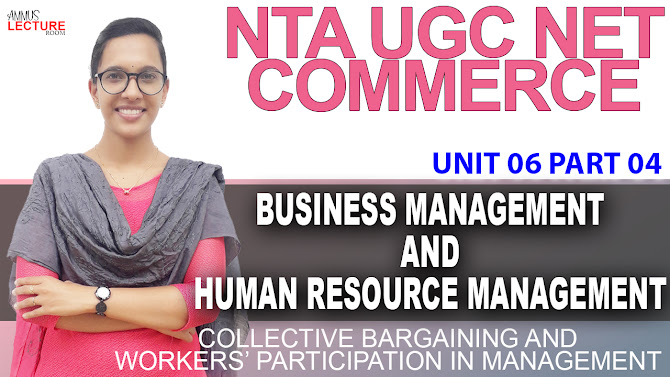- Get link
- X
- Other Apps
- Get link
- X
- Other Apps
VIDEO LINK
UNIT 06
Business Management and Human Resource Management
PART 04
- Collective bargaining and workers’ participation in management -
The phrase ‘Collective Bargaining' is coined by famous authors Sydney and Beatrice Webb in their celebrated treatise on ‘History of Trade Unions’.
Collective Bargaining is a method of determining the terms and conditions of employment and settling disputes arising from those terms by negotiating between the employer and the employees or their trade union.
The term collective bargaining is made up of two words, ‘collective’ – which means a ‘group action’ through representation and ‘bargaining’, means ‘negotiating’,
Thus it means collective negotiations between the employer and the employee, relating to their work situations.
The term collective bargaining is made up of two words, ‘collective’ – which means a ‘group action’ through representation and ‘bargaining’, means ‘negotiating’,
Thus it means collective negotiations between the employer and the employee, relating to their work situations.
Types of Collective Bargaining
1. Conjunctive or Distributive Bargaining:
In this form of collective bargaining, both the parties viz. The employee and the employer try to maximize their respective gains. It is based on the principle, “my gain is your loss, and your gain is my loss” i.e. one party wins over the other.
The economic issues such as wages, bonus, other benefits are discussed, where the employee wishes to have an increased wage or bonus for his work done, whereas the employer wishes to increase the workload and reduce the wages.
The economic issues such as wages, bonus, other benefits are discussed, where the employee wishes to have an increased wage or bonus for his work done, whereas the employer wishes to increase the workload and reduce the wages.
2. Co-operative or Integrative Bargaining:
Both the employee and the employer sit together and try to resolve the problems of their common interest and reach to an amicable solution. In the case of economic crisis, such as recession, which is beyond the control of either party, may enter into a mutual agreement with respect to the working terms.
For example, the workers may agree for the low wages or the management may agree to adopt the modernized methods, so as to have an increased production.
For example, the workers may agree for the low wages or the management may agree to adopt the modernized methods, so as to have an increased production.
3. Productivity Bargaining:
This type of bargaining is done by the management, where the workers are given the incentives or the bonus for the increased productivity. The workers get encouraged and work very hard to reach beyond the standard level of productivity to gain the additional benefits.
Through this form of collective bargaining, both the employer and the employee enjoy the benefits in the form of increased production and the increased pay respectively.
Through this form of collective bargaining, both the employer and the employee enjoy the benefits in the form of increased production and the increased pay respectively.
4. Composite Bargaining:
In this type of collective bargaining, along with the demand for increased wages the workers also express their concern over the working conditions, recruitment and training policies, environmental issues, mergers and amalgamations with other firms, pricing policies, etc. with the intention to safeguard their interest and protect the dilution of their powers.
Workers participation in management
Workers participation in management refers to the participation of non-managerial employees in the decision-making process of the organisation. Workers participation gives employees the mental and psychological satisfaction and thereby increase their involvement in the affairs of the organization.
Methods of Workers’ Participation in Management:
Suggestion scheme
Under this method the suggestions from the workers are invited
Under this method the suggestions from the workers are invited
Co-partnership:
Co-partnership allows workers to participate in decision making. Under this method the employees get shares of the company and establish their ownership.
Representation on Board of Directors:
One or two representatives of the workers are nominated on the BOD Works Committees: The Industrial Disputes Act 1947 provides for establishing works committees in every establishment employing hundred or more workers. This is made compulsory to ensure workers’ participation through legislation. The work committee consists of equal number of members of workers and employer. The object of establishing works committees is to promote healthy industrial relations.
One or two representatives of the workers are nominated on the BOD Works Committees: The Industrial Disputes Act 1947 provides for establishing works committees in every establishment employing hundred or more workers. This is made compulsory to ensure workers’ participation through legislation. The work committee consists of equal number of members of workers and employer. The object of establishing works committees is to promote healthy industrial relations.
Joint Management Councils:
Industrial Policy 1956 of government of India has stressed on joint consultation between management and workers to maintain industrial peace and to promote better industrial relations in the prime sector of industries. The joint management councils received recognition during second five year plan. Under this system consultative committees are set up consisting of representatives of employees and employers both.
Levels of workers participation in management
Information participation of workers:
It ensures that employees are able to receive information and express their views
Consultative participation of workers:
Under this kind of workers participation in management, May act as a consultant in the matters of workers safety, health and their welfare at workplace.
Associative participation of workers:
under associative participation of workers in management, morally bound to accept and implement the opinion of employees.
Administrative participation of workers:
Here employees take part in decisions, which were already taken by the management, thereupon employees have to select the best from those decisions for the purpose of implementation.
Decisive participation of workers:
Employees and management together taking decisions on the matters related to workers welfare and production related issues
-------------------------------------------------------
- Get link
- X
- Other Apps


Comments
Post a Comment